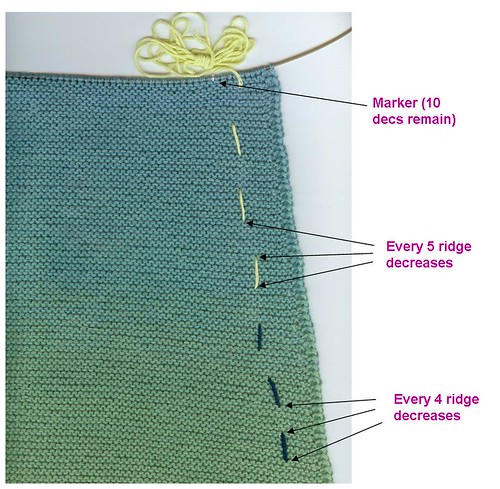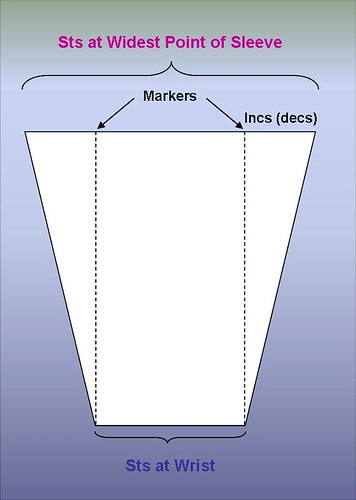Wow — Sally’s new Japanese sweater is a tough act to follow, so I won’t even try. Her sweater is absolutely stunning, and I can’t wait to see it in person. I will be doing that soon, as I head east for another foray into the exciting world of the Maryland Sheep and Wool Festival — first weekend in May!!
So, what have I been up to? I have been working on Sleeve #1 of my Ode to Joy and also doing the prep work for the upcoming knitters guild program. The sleeve seems particularly slow, even for a sleeve. Could it be because I need to add 60 rows to obtain the length I need? Hmmm, maybe.
Since my knitting life is far more boring than Surly’s, I thought I would share a couple of tricks I have gleaned over the years.
Counting 1-2-3
Many steps in the knitting process require counting: counting rows between cable crossings, increases, decreases, etc. This requires keeping track of said counting. Row counters that have to be turned, hash marks that have to be written down, will all fail you because they rely on you remembering to do something. Each and every time. No forgetting. Ever. And I have found that I am not reliable! So I have learned to let my knitting to do the counting for me.
Your knitting will never lie to you.
Counting Rows with Waste Yarn
My favorite method for counting rows has been mentioned many times on our blog. It is one of the best tips of the trade I have ever found (Sally likes it, too).
Let’s use the example of sleeve increases. They are done every “x” number of rows. In our example, let’s say the increases are to be done every 6 rows.
On the row that you do the first increase, you ** work the increase and knit a few sts. Place the waste yarn between the stitch you just worked (the last st on the RH needle) and the next one to be worked (1st stitch on the LH needle). Yep. it just lays there between the two sts. Now knit the row normally, working the second increase at the end of the row.
The running thread of the row you just worked will hold the waste yarn in place and counts as one row. Work 5 more rows. Now there are 6 rows above the point where the waste yarn was placed. Since we are doing our increases every 6 rows, it is time to do another increase. Repeat from **, weaving the waste yarn from front to back, or back to front (this step alternates), on each row that an increase is made. If I forget to weave the waste yarn — I just pull it through under the running thread on the next row.
Your knitting will look like the sleeve shown here:

Each “slash” represents 2 decreases — here you see 6 decs every 4 ridges and 7 every 5 ridges
I am doing decreases because this is a top down sleeve, but the principle is the same.
I changed the color of my waste yarn to show where I changed from every 4th to every 5th ridge decs, though this is not really necessary. I do not remove the waste yarn when I’m done with the first sleeve — it tells the sleeve’s story. What happens if I get side tracked on a project? Can’t find my notes? Put the project away for months (years??!!) and now I want to start the second sleeve? My waste yarn tells the story.
Counting Increases with Markers
The other thing I do is something I started out of necessity: I really must get distracted easily — like, before I get to the end of the row! ![]() Have you ever forgotten to do the second increase (decrease) on a sleeve? You eventually count your sts and find out the count is off.
Have you ever forgotten to do the second increase (decrease) on a sleeve? You eventually count your sts and find out the count is off.
Where is the missing stitch? You look carefully along each edge and BINGO. There it is (or should I say isn’t). Back about 5 inches on the left hand side of the sleeve! You have two choices: rip back (ugh) or fudge and add the stitch. The fudged sleeve will end up a bit funky, and you’ll always know the mistake is there (ugh).
To avoid this, I use stitch markers to show how many increases (or decreases) I actually did vs how many I was supposed to do. For a bottom-up sleeve, after a few rows and increases, I place markers to mark off my original sts. The increases will be on either side of the markers.
The number of sts on each side of the markers must always be equal and always equal to the number of increases indicated by my waste yarn (3-3-3, 10-10-10…always equal). I count these sts every so often — if the numbers don’t match, I catch it early and don’t have much ripping to do.

With top down sleeves, you start at the widest point in the sleeve. The markers show where you will end up and the total number of decreases will be on either side of the markers. As you work the sleeve decreases, the number of completed decreases (indicated by your waste yarn) plus the remaining sts on each side of the markers, need to equal the total number of decs.
Whew! This is a lot of writing for a very easy concept. I hope you find it useful. I know it has saved me a lot of time, stress, and concentration.
I can count without counting! ![]() Now you know exactly how lazy I am!!
Now you know exactly how lazy I am!!

















What great ideas! Thanks
Comment by Anna Marie — April 1, 2009 @ 6:11 am
Thanks for the hints, Susan. We rookies need all the help we can get.
Comment by Wendy O'C — April 1, 2009 @ 6:24 am
You’re so right. The hardest thing about counting is remembering to count!
Comment by Brigid — April 1, 2009 @ 6:47 am
What is it about counting that’s so hard? I don’t know, but it is.
Comment by surly — April 1, 2009 @ 8:04 am
I have all sorts of little I’m too lazy to count tricks, but your sleeve increases tip is brilliant — in my next class I’ll be calling it the Susan Rainey tip, and they’ll all be wowed.
Comment by mary lou — April 1, 2009 @ 8:21 am
That is a brilliant tip for a person who has yet to attempt her first sweater! Thank you so much!
Comment by Jaclyn Bailey — April 1, 2009 @ 9:28 am
Not lazy at all – just smart! I’ll definitely be stealing this tip!
Comment by LisaW — April 1, 2009 @ 10:11 am
Thanks for these great tips! I too can forget what should be happening by the end of the row!
Comment by Jan — April 1, 2009 @ 10:29 am
I thought I was relatively intelligent till I started knitting. I have found I cannot be relied on to count to 2. Have you any idea how much time this will save me?
I imagine that you do, bless your sweet soul.
Comment by Needles — April 1, 2009 @ 10:46 am
Great ideas – thanks!
Comment by Cheryl S. — April 1, 2009 @ 11:11 am
You are simply brilliant. Brilliant. I love this. Brilliant.
Comment by Kendyl Young — April 1, 2009 @ 11:51 am
Simple and effective; brilliant!
I bow in awe to the Rainey Sisters — Knitting Goddesses!
Comment by CreeksideKnitter — April 1, 2009 @ 11:56 am
Great tips – simple and straightforward and nothing extra to keep track of.
Thanks! I have a sweater coming up that I’ll try them on.
Comment by Linda in NC — April 1, 2009 @ 12:19 pm
I love both tips, but especially the one for using waste yarn on the sleeve, or for cabling, or whatever one is supposed to do on however many rows for however many rows. I have an ornately cabled sweater in my queue for my husband, and this great tip will be put to use on it.
Comment by dana — April 1, 2009 @ 2:22 pm
Hi Susan and Sally,
I have been reading (lurking) for quite some time, but this may be my first comment!
Thanks for the great tips! You both do some amazing knitting.
If you two are at the MD Sheep and Wool Fest. on Sunday before 11:00 stop by the Sheep to Shawl contest and say “Hi”. I’ll be weaving, but would love to meet you both!
Beth P. in Maryland
Comment by Beth P. — April 1, 2009 @ 3:58 pm
thanks for the tips.Brilliant?
Comment by cici — April 1, 2009 @ 4:44 pm
This advice is just what I needed today. My little girl likes playing with the row counter a lot. No more worries in that regard. This is such a simple solution. Thanks!
Comment by Claudine — April 1, 2009 @ 5:12 pm
Now, why didn’t I think of that! Thanks so much. I’ll be passing these tips along to my classes. Isn’t that what knitting is all about – passing it along, or paying it forward.
Comment by Nancy — April 1, 2009 @ 6:21 pm
I use the stitch marker trick, too, but I also have an extra safety pin type marker that I pin to the end of the row right when I do the decrease/increase at the beginning of the row. That way, when I get to the end I hit the marker and get reminded that I am supposed to be doing something there.
Nice bit of detail changing colors where the decrease rate changes!
Comment by twinsetellen — April 1, 2009 @ 9:32 pm
I totally agree with Needles. Used to think I was intelligent. Never thought that yarn would outsmart me. But it has, and it keeps doing it. Maybe I can sneak up on it this time with your handy dandy tips. Thanks bunches!
Comment by 2muchfun — April 2, 2009 @ 12:26 am
Those are great ideas. No matter how good a knitter one is — and you are a very, very good one — we all need a little help along the way. Thanks!
Comment by kmkat — April 3, 2009 @ 11:06 pm
Great ideas for counting! Thanks.
Comment by jen — April 4, 2009 @ 12:07 pm
I have been remiss on reading all the knitting blogs that I regularly read due to a year’s worth of course study of another subject. So, I am taking the remainder of my summer vacation to catch up on the blogs I love the most. (Bingo – you are one of the lucky blogs!) That explains why my timing is a bit off with this comment.
Onto the comment. First – you two have put out some beautiful pieces in the past year! Bravo!
Second. The st. marker idea to mark dec/inc is wonderful!!! Thank you so much for sharing it!
Comment by Susan — July 21, 2009 @ 12:54 am